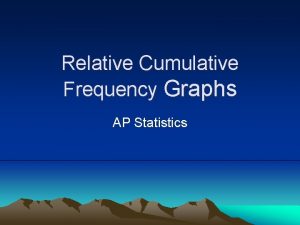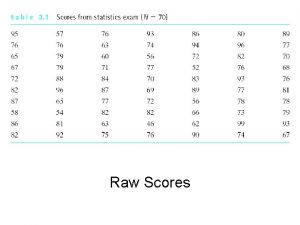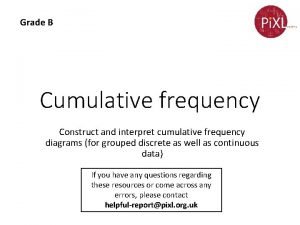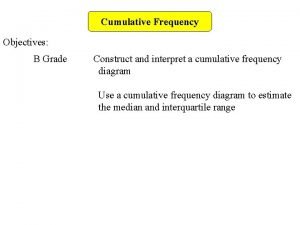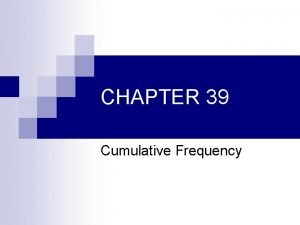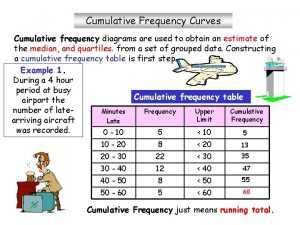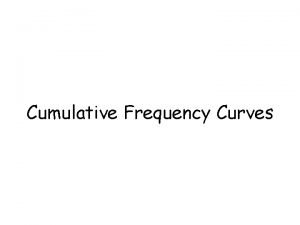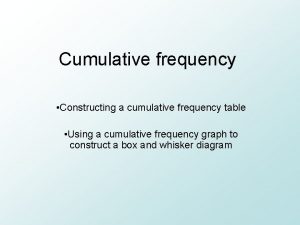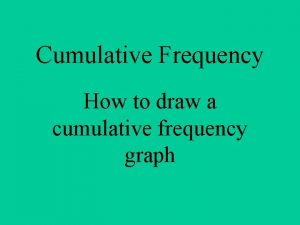Cumulative Frequency Graphs Worksheet A Printing To print







- Slides: 7

Cumulative Frequency Graphs – Worksheet A

Printing To print handouts from slides Select the slide from the left. Then click: File > Print > ‘Print Current Slide’ To print multiple slides Click on a section title to highlight all those slides, or press ‘Ctrl’ at the same time as selecting slides to highlight more than one. Then click: File > Print > ‘Print Selection’ To print double-sided handouts Highlight both slides before using ‘Print Selection’. Choose ‘Print on Both Sides’ and ‘Flip on Short Edge’.



1) 50 students took a Geography test. Their results were put into 4 groups. 3) Mr Smith has drawn a cumulative frequency graph for the results of his Year 9 students. A) Complete the table to find the cumulative frequency. B) Plot the table data on the graph. 50 Cumulative Coord. Frequency 0 -20 5 5 ( 20, 5 ) 21 -40 22 27 ( 40, 27 ) 41 -60 14 41 ( 60, 41 ) 61 -80 9 50 ( 80, 50 ) 40 Lower Quartile→ Median 30 10 0 D) We want to find the median. With grouped data we can estimate and use n ÷ 2 Plot a line from n ÷ 2 to the curve. What is the estimate the median? 38 for marks 2) 30 students take a Science test. Their results are put into 6 groups. C. F. 11�m� 20 2 2 21�m� 30 7 9 31�m� 40 9 18 41�m� 50 8 26 51�m� 60 3 29 61�m� 70 1 30 Cumulative frequency F. 30 20 Median 10 20 A) Find an estimate for the median 30 Upper Quartile 20 Median 10 40 Mark 50 60 36 marks 70 10 13 20 30 31 40 50 Mark 60 60 70 80 Mr Smith wants to measure the spread of the data, but he wants to eliminate extreme values and focus on the middle 50%. To do this he marks the first quarter (Lower-Quartile) and third quarter (Upper Quartile) of the data. 47 marks A) What is the interquartile range? 4) The data for Mr Smith’s Year 10 students is in the table. A) Complete the cumulative frequency graph. B) Find the median and the interquartile range. M = 37 Mark (m) F. C. F. 0�m� 10 2 2 11�m� 20 3 5 21�m� 30 9 14 31�m� 40 13 27 Better 41� m� 50 10 0 30 0 0 20 40 60 80 C) Join the points with a curve. Mark Yes, instead? a Frequency Polygon Could we join points with straight lines Should we start the curve at ( 0, 0 ) ? Yes Mark (m) 40 IQR = 18 50 Cumulative frequency Mark Frequency Cumulative frequency Remember we plot each group at its highest value. Cumulative frequency Cumulative Frequency Curves 40 UQ 30 Median 20 LQ median. 14 41 10 Smaller 51� m� 60 6 IQR 47= 0 more consistent 0 10 20 30 40 50 60 70 61�m� 70 2 49 Mark 47 29 37 results for the 71�m� 80 1 50 middle 50% C) What comparisons can you make between Mr Smith’s Year 9 and Year 10 students? 80

Cumulative Frequency Curves 1) 50 students took a Geography test. Their results were put into 4 groups. A) Complete the table to find the cumulative frequency. B) Plot the table data on the graph. 50 0 -20 5 21 -40 22 41 -60 14 61 -80 9 Cumulative Coord. Frequency 40 Lower Quartile→ 30 10 0 20 C) Join the points with a curve. Could we join points with straight lines instead? Should we start the curve at ( 0, 0 ) ? 40 60 Mark 80 D) We want to find the median. With grouped data we can estimate and use n ÷ 2 Plot a line from n ÷ 2 to the curve. What is the estimate for the median? 11�m� 20 2 21�m� 30 7 31�m� 40 9 41�m� 50 8 51�m� 60 3 61�m� 70 1 2) 30 students take a Science test. Their results are put into 6 groups. C. F. Cumulative frequency F. 30 20 10 20 A) Find an estimate for the median 30 30 Upper Quartile 20 Median 10 0 0 20 0 Mark (m) 40 40 Mark 50 60 70 10 20 30 40 50 Mark 60 70 80 Mr Smith wants to measure the spread of the data, but he wants to eliminate extreme values and focus on the middle 50%. To do this he marks the first quarter (Lower-Quartile) and third quarter (Upper Quartile) of the data. A) What is the interquartile range? 4) The data for Mr Smith’s Year 10 students is in the table. A) Complete the cumulative frequency graph. B) Find the median and the interquartile range. Mark (m) F. 0�m� 10 2 11�m� 20 3 21�m� 30 9 31�m� 40 13 41�m� 50 14 51�m� 60 6 61�m� 70 2 71�m� 80 1 C. F. 50 Cumulative frequency Mark Frequency Cumulative frequency Remember we plot each group at its highest value. Cumulative frequency 3) Mr Smith has drawn a cumulative frequency graph for the results of his Year 9 students. 40 30 20 10 0 0 10 20 30 40 50 Mark 60 70 C) What comparisons can you make between Mr Smith’s Year 9 and Year 10 students? 80

Questions? Comments? Suggestions? …or have you found a mistake!? Any feedback would be appreciated . Please feel free to email: tom@goteachmaths. co. uk

